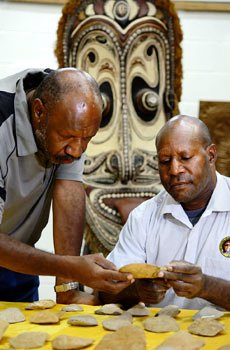Safeguarding PNG's culture for future generations
 Papua New Guinea has a rich cultural history unlike any other nation on earth.
Papua New Guinea has a rich cultural history unlike any other nation on earth.
Ensuring the protection of this unique cultural heritage has been a key priority since the inception of the PNG LNG Project.
Prior to the start of construction, we established a Cultural Heritage Management Plan, which included commissioning detailed studies alongside extensive community consultation to identify culturally significant sites within Project areas.
Sites were considered culturally important if they were significant in any of the following ways: socially, politically, scientifically, historically, educationally, economically or aesthetically.
A range of locations were identified including caves, burials, sacred stones sites, settlements, sacrifice sites, old villages, artefacts, and World War II equipment and aircraft.
Our archaeologists worked closely with the PNG National Museum and Art Gallery and the local community to develop plans that would minimise potential impacts to each of these sites during construction.
Wherever possible culturally significant sites were avoided, however in a few instances avoidance was not possible and here we engaged cultural heritage specialists to salvage materials or carry out relocations according to local custom.
Unknown archaeological sites, including skeletal remains discovered during archaeological salvage or construction activities, were referred to as ‘chance finds’.
As part of the Cultural Management Plan we had a Chance Finds Protocol, which provided a set of procedures to manage the preservation and appropriate treatment of chance finds during construction. The use of the Chance Finds Protocol continues during production to manage the treatment of any cultural finds during production-related construction activities.
During operations, we continue to monitor cultural heritage sites that were avoided or mitigated during construction and are within close proximity to the project facilities to ensure no further impact. An archaeologist is part of the site environmental team to provide guidance and increase awareness of the rich diverse cultural setting we operate within.